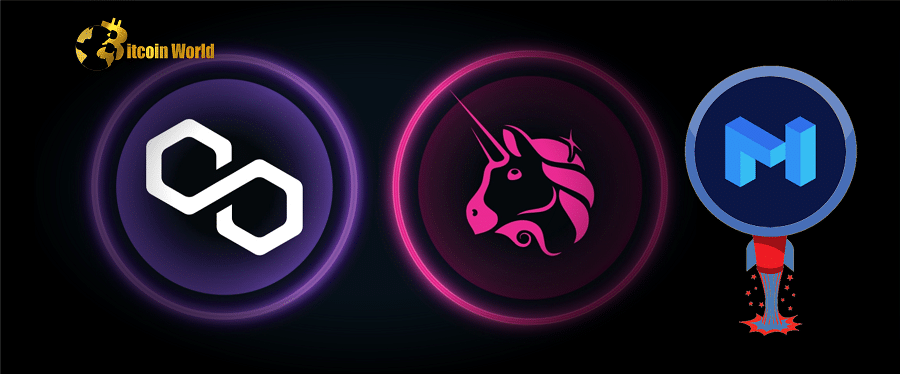In the wild world of crypto, bear markets can feel like an endless winter. But amidst the chill, some projects are showing surprising resilience. Take Polygon (MATIC), for example. While the overall market has been, shall we say, less than enthusiastic, Polygon’s decentralized finance (DeFi) sector has been heating up. Let’s dive into what’s been happening and what it means for the future.
Why is Polygon’s DeFi Sector Thriving?
Despite the market downturn, Polygon has been making significant strides in the DeFi space. A key driver of this growth has been strategic collaborations, particularly with major players like Uniswap (UNI). Think of it as a powerful alliance boosting both ecosystems.
The Uniswap Effect: A Win-Win Collaboration
Polygon’s partnership with decentralized exchanges (DEXes) like Uniswap has proven to be a game-changer. How so?
- More Traders on Uniswap: Polygon’s infrastructure has helped bring a fresh wave of users to the popular DEX.
- Enhanced Liquidity Rebalancing: The collaboration facilitates smoother and more efficient liquidity management for various protocols.
But it’s not just Uniswap that’s benefiting. Polygon itself is seeing a tangible positive impact on its DeFi landscape.
Quantifying Polygon’s DeFi Success: The Numbers Don’t Lie
Let’s look at the data to understand the extent of Polygon’s DeFi boom:
- Total Value Locked (TVL) Soars: Over the past week, Polygon’s TVL has experienced a significant jump, increasing by a substantial $50 million. This signifies a greater amount of assets being utilized within the Polygon DeFi ecosystem.
- dApp Activity on the Rise: Data from DappRadar reveals a surge in activity across the majority of decentralized applications (dApps) built on Polygon. More unique active wallets are engaging with these applications.
What’s Fueling This DeFi Frenzy on Polygon?
One major factor contributing to this increased DeFi activity is the cost-effectiveness of the Polygon network.
- Low Gas Fees: Polygon is well-known for its significantly lower gas fees compared to the Ethereum mainnet. This makes it more accessible and attractive for users to conduct DeFi transactions.
- Increased Gas Block Usage: According to Dune Analytics, the average gas block usage on Polygon has seen a notable increase recently, indicating higher network utilization.
The Impact on Polygon’s Revenue: A Positive Surge
Increased activity often translates to higher revenue. Token Terminal data confirms this trend for Polygon:
- Revenue Spike: Polygon’s revenue witnessed an impressive surge, increasing by 97.3% in a single 24-hour period.
- Significant Earnings: At the time of writing, Polygon’s total revenue stood at a healthy $2.6 million.
The DEX Dilemma: A Slight Dip in Activity
While the overall DeFi picture for Polygon looks bright, there’s a slight contradiction in the DEX activity. Over the last three months, DEX volume on Polygon has seen a decrease, falling from $95.98 million to $55.35 million. This suggests that while more users are engaging with DeFi on Polygon, their activity might be shifting towards other types of dApps or protocols.
The MATIC Token: Not Feeling the DeFi Love?
Here’s the interesting part: despite the positive developments in Polygon’s DeFi space, the native token, MATIC, hasn’t experienced a corresponding price surge. Why is this the case?
Analyzing MATIC’s Performance: A Mixed Bag
- Stagnant New Addresses: Polygon hasn’t been successful in attracting a significant number of new addresses to the MATIC network recently, as indicated by a decrease in network growth over the past month.
- Negative Sentiment for Holders: The MVRV (Market Value to Realized Value) ratio for MATIC remains negative. This implies that, on average, existing MATIC holders would incur losses if they sold their holdings at the current price.
A Glimmer of Hope: Increased Daily Active Addresses
Despite the challenges faced by the MATIC token, there’s a positive sign to consider:
- Surge in Daily Activity: The number of daily active addresses on the Polygon network has increased in recent days. This heightened activity could potentially influence MATIC’s price trajectory in the near future, suggesting a possible turnaround.
Key Takeaways and What to Watch For
Polygon’s DeFi sector is demonstrating remarkable strength amidst the bear market. Collaborations, low gas fees, and increasing dApp activity are driving growth. However, the price of the MATIC token hasn’t yet reflected this positive momentum. Keep an eye on the following:
- Sustained DeFi Growth: Will the upward trend in TVL and dApp activity continue?
- MATIC Price Action: Can the recent increase in daily active addresses translate into positive price movement for MATIC?
- DEX Activity: Will DEX volumes on Polygon rebound?
- New Partnerships: Are there more collaborations on the horizon that could further boost the ecosystem?
In Conclusion: A Story of Resilience and Potential
Polygon’s current situation presents a fascinating dichotomy. Its DeFi ecosystem is flourishing, showcasing the power of its technology and strategic partnerships. While the MATIC token’s performance hasn’t mirrored this success yet, the underlying fundamentals and increasing network activity offer a glimmer of hope. The coming weeks and months will be crucial in determining if Polygon can translate its DeFi dominance into broader success for its native token. One thing is clear: Polygon is a project to watch closely in the ever-evolving landscape of crypto.
Disclaimer: The information provided is not trading advice, Bitcoinworld.co.in holds no liability for any investments made based on the information provided on this page. We strongly recommend independent research and/or consultation with a qualified professional before making any investment decisions.


